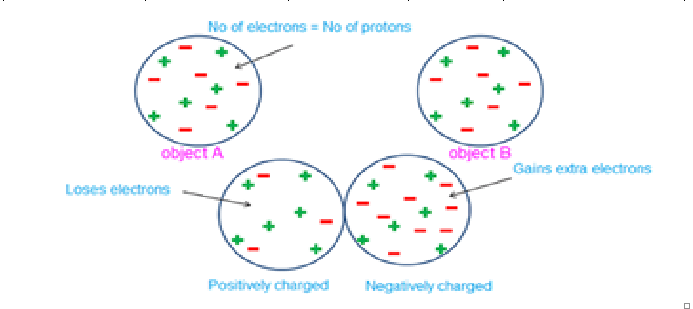Chapter 1
Electric Charges and Fields
Topics Covered : Basic properties of electric charge
Basic properties of electric charge
Quantisation of charge
The quantisation of charge was first suggested by the experimental laws of electrolysis discovered by English experimentalist Faraday. It was experimentally demonstrated by Millikan in 1912.
The cause of the quantization of the electric charge is due to the fact that when one body is rubbed with the other, an integral number of electrons transferred.
It is the property by virtue of which all free charges are integral multiples of a basic unit of charge denoted by e. Thus charge q on a body is always given by
q = ne where n is any integer, positive or negative.
This basic unit of charge is the charge that an electron or proton carries. By convention, the charge on an electron is taken to be negative; therefore charge on an electron is written as –e and that on a proton as +e.
The value of the basic unit of charge is e = 1.602192 × 10–19 Coulomb
SI Unit of charge Coulomb and is denoted by the symbol C.
Additivity of charges
It is a property by virtue of which total charge of a system can be calculated by adding algebraically all the charges present anywhere on the system.
If a system contains two point charges q1 and q2, then the total charge of the system is obtained by simply adding q1and q2, i.e., charges add up like real numbers.
If a system contains n number of charges q1, q2,q3, q4, – – – – – – ,qn, then the total charge of the system is q1 + q2 + q3 + q4 + – – – – – – – – + qn.
Charge is a scalar quantity; it has magnitude but no direction, similar to mass. However, there is one difference between charge and mass. Mass of a body is always positive whereas charge can be either positive or negative.
Let us take for example, the system containing four charges q1 = +2C, q2 = +3C, q3 = -3C, q4 = +4C, then the total charge of the system is
q = q1 + q2 + q3 + q4
= (+2) + (+3) + (-3) + (+4)
= +6C
Therefore, the total charge of the system is +6C and it is positively charged.
Charge is conserved
It is the property by which of which the total charge of an isolated system remains constant.
The law of conservation of charge states that charge cannot be created or destroyed. However, a charge can be transferred from one object to other.
Let us consider two objects, object A and object B. Object A has equal number of electrons and protons. So, it is electrically neutral. Similarly, object B has equal number of electrons and protons. So, it is also electrically neutral.

Before rubbing total number of protons and electrons were
On A np = 6 and ne = 6
On B np = 6 and ne = 6
Total on A & B np = 12 and ne = 12
After rubbing total number of protons and electrons were
On A np = 6 and ne = 3
On B np = 6 and ne = 9
Total on A & B np = 12 and ne = 12
When object A and object B are rubbed with each other, negative charges from object A can be transferred to object B. Hence, object B has more number of electrons than protons due to gaining of extra electrons. Similarly, object A has lesser number of electrons than protons due to losing of some electrons.
Therefore, object A becomes positively charged and object B becomes negatively charged.
NOTE:
- It is not possible to create or destroy net charge carried by an insulated system.
- Charges can be created or destroy in equal and unlike pairs only.
